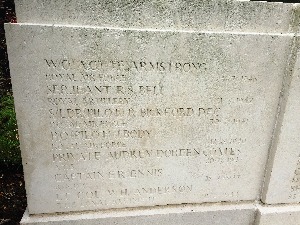
Darlington West Cemetery name plaque

Northern Echo Tuesday 1st Setember 1942
Parents Charles Arthur Sanderson Bell (1876-1911) and Gertrude Annie Stainthorpe (1876-1941) married in 1897 in Darlington. In the 1901 Census the couple are found living at 43, St. Johnís Crescent, Darlington with Charlesí mother Ellen Ann Bell (widow) who is head of the household. All three family members are listed as ďliving on own meansĒ under profession or occupation. Charles and Gertrudeís son Robert Sanderson Bell was born on the 25th February 1902, in Darlington.
In 1907 Robert is listed in the admissions book as attending Waterhouses British Mixed School (also known as Peases West Brandon British, which became Waterhouses Council Mixed) in Darlington.
In the 1911 Census Robert and his family are still living at 43, St. Johnís Crescent, Bank Top, Darlington. Remaining as head of the household is Ellen Ann Salter (age 70) who has now remarried, and also listed as residing at this address is Alfred Henry Sanderson (age 43) and Robertís parents Charles (age 34) and Gertrude (age 35). Alfred is employed as a butcher and Charles is a retired fitter, but sadly later the same year Charles passed away when his son Robert was only 9 years old.
In 1928 in Darlington Robert married Mabel Kate Nichols. Mabel (known as Kitty) was born in Northallerton, Yorkshire in 1902, but is found living with her family in Elmfield Terrace, Darlington in 1911.
There are three births registered for the couple, John R. born 1929, Mary E. born 1930 and David H. born 1932.
The 54th Searchlight Regiment, Royal Artillery
The 5th Battalion Durham Light Infantry was reformed in the 1920ís and was a Territorial Battalion (TA) comprising of part time volunteer soldiers who then became full time soldiers following the outbreak of WW2. The 5th Battalion served in an anti-aircraft role in WW2. They had transferred to the Royal Engineers and converted into a searchlight battalion in October 1938 and were consequently divided into the 1/5th and 2/5th, which then became the 54th and the 55th Searchlight Regiments, Royal Artillery respectively. The move to Royal Artillery was in August 1940.
Robert is known to have served with the 1/5th DLI, which became the 54th Searchlight Regiment, Royal Artillery and he attained the rank of Sergeant.
Searchlights had the job of picking out enemy aircraft in their beams for the anti-aircraft guns to target. Later in the war some were used to provide reflected light during night attacks to improve the visibility for attacking Allied troops.Prior to their conversion into a searchlight regiment the Battalion attended TA training camps during the summer. They were on Skelder Moor, near Whitby in the summer of 1937 and at Alnwick in Northumberland in 1938.
The Battalion as a whole attended the summer camp of 1938 for preliminary training in searchlights but the equipment provided for this training was inadequate. Things improved when Lieutenant Colonel David Marley became commanding officer of the 1/5th, as after this appointment intensive spare time training began. Additionally a company of A.T.S. (The Auxiliary Territorial Service, the womanís branch of the British army) became attached to the Regiment.
In July 1939 batteries began to occupy searchlight sites in the areas of Sedgefield and Guisborough. By the time war was declared 413 battery had deployed at Filey, 411 battery at Malton and 412 battery at Easingwold with Regimental Headquarters. (Robert was with 413 battery).
The winter of 1939 was severely cold, and the men were on isolated and exposed sites and did not see service abroad. Their commanding officer transferred to the 10th battalion DLI and he was succeeded by Lieutentant-Colonel J. K. Reay, who remained in command until March 1945.
The Regiment underwent special infantry training to prepare and defend against any type of German attack along the Yorkshire coastal areas. German air raids began in the summer and autumn of 1940 and the troop site at Flamborough Head was one of the first to be bombed. This was followed by the troop site at Reighton, which was several miles inland.
During 1940 to 1944 the Regimental area was extended to incorporate a few miles north of Scarborough to within a few miles of Hull and included the area bounded by York, Harrogate, Ilkley and Beverley and the men continued their roles across the numerous sites.
The Regiment destroyed several German bombers during the Battle of Britain, and by the middle of 1944 had been selected as the second Searchlight Regiment in Anti-Aircraft Command for overseas service. On the 11th November Regimental Headquarters and two batteries embarked for Normandy.
Sergeant Robert Sanderson Bell however did not see service abroad as he died on the 31st August 1942 age 40. He passed away at his home at 45, St. Johnís Crescent, Darlington, with his wife in attendance. The cause of death was given as cardiac failure and tumours of the lung. Robertís occupation was given as a Turner in the Engineering Works.
Robert left a will, leaving his effects to his wife Mabel and her brother John Sidwell Nichols.
Robertís wife Mabel Kate (Kitty) died at the Moorlands Nursing Home 6th March 1992.
Research : Jean Atkinson/James Pasby
He is remembered at Darlington on D47.064

